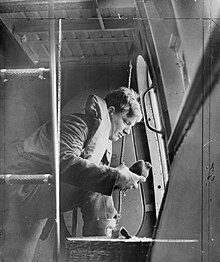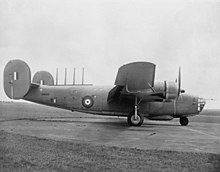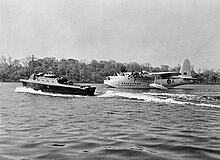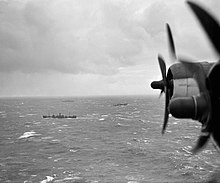| No. 15 (Reconnaissance) Group RAF | |
|---|---|
 | |
| Active | 1 April 1918 – 1 September 1919 15 March 1939 – 1 August 1945 |
| Country | |
| Branch | |
| Type | Royal Air Force group |
| Role | Maritime Reconnaissance (1939-1945) |
| Part of | RAF Coastal Command |
| Motto(s) | Dion's Buail (Gaelic: "Protect and Attack") |
| Engagements | World War II |
| Commanders | |
| Notable commanders | Air Marshal Sir Leonard Horatio Slatter KBE, CB, DSC & Bar, DFC, DL |
No. 15 Group (15 Gp) was a group of the Royal Air Force, which disbanded in 1945. It was operational in the last year of, and just after, the First World War, a reformation saw it active throughout the Second World War.
History
First World War
No. 15 Group was first formed on 1 April 1918 as No. 15 (Equipment) Group in the No. 3 Area, which became the Midland Area on 8 May 1918. It was disbanded, and then reformed on 27 September 1918 as No. 15 (Aegean) Group to control 62 and 63 Wings, until finally disbanded on 1 September 1919.
Second World War
See also: RAF Coastal Command during World War IIEarly War
The group was reformed on 15 March 1939 as No. 15 (Reconnaissance) Group, part of RAF Coastal Command, at Lee-on-Solent. It comprised Royal Air Force squadrons, with attached Naval Air Squadrons from the Royal Navy's Fleet Air Arm, operating under Royal Air Force control. No. 15 Group relocated its headquarters to Mount Wise, Plymouth, on 6 June 1939. By November 1939, No. 15 Group, under Air Commodore Rey Griffith Parry, DSO, had expanded to ten units operating across six Royal Air Force stations. It had three squadrons equipped with Short Sunderland flying boat patrol bomber. Two, Nos. 210 and 228 Squadrons, were stationed at RAF Pembroke Dock, in Pembrokeshire, Wales, with the third squadron, No. 204, operating out of RAF Mount Batten, in Devon, England. The group had two units operating with Avro Anson, a twin-engined multi-role aircraft, across four stations, No. 502 Squadron, was based at RAF Aldergrove, in Northern Ireland and which also had a detachment at RAF Hooton Park, in Cheshire, England, and No. 217 Squadron, based at RAF St Eval, in Cornwall, England, which also operated a flight out of RAF Carew Cheriton, situated in Pembrokeshire, Wales. No. 3 and No. 5 Coastal Patrol Flights, both equipped with de Havilland Tiger Moth, a biplane trainer aircraft, and de Havilland Hornet Moth, a cabin biplane, were based at RAF Hooton Park and RAF Carew Cheriton respectively.
The following year, in August 1940, the headquarters moved to Egg Buckland Keep, and a final move in early 1941 saw it transfer to Derby House, Liverpool. Its squadrons provided support and convoy escorts, maritime reconnaissance and anti-submarine warfare in the South West, Western Approaches and the Irish Sea. Air Vice-Marshal James Robb was appointed Air Officer Commanding, replacing Air Commodore Rey Griffith Parry, on 23 February 1941.

On 9 April 1941 it took control of Royal Air Force units in Iceland. It continued to operate from Liverpool for the rest of the Second World War. By May 1941, No. 210 Squadron had moved to RAF Oban, located in Argyll and Bute, Scotland. It operated with Short Sunderland but was re-equipping to Consolidated Catalina. No. 502 Squadron was now operating with Armstrong Whitworth Whitley, a medium bomber, and was based alongside No. 211 Squadron, equipped with Vickers Wellington, a long-range medium bomber, at RAF Limavady, near the city of Derry, Northern Ireland. At RAF Lough Erne, in County Fermanagh, Northern Ireland, Nos. 209 and 240 Squadrons both operated with Consolidated Catalina, but were also equipped with Saunders-Roe Lerwick and Supermarine Stranraer respectively. No. 119 Squadron had reformed at RAF Bowmore, Strathclyde, Scotland, on 13 March 1941 as part of No. 15 Group. The squadron was equipped with three Short G class and two Short C class flying boats. RAF Hooton Park was home to the Group Communications Flight, which operated various types and marks of aircraft, and also home to a No. 48 Squadron flight which was formed of Avro Anson. The squadron also had a similar flight at RAF Port Ellen, on the island of Islay in Argyll and Bute. RAF Aldergrove was home to No. 233 Squadron, equipped with Lockheed Hudson and No. 252 Squadron which operated with Bristol Beaufighter.

On 4 April 1942, Air Vice-Marshal Douglas Colyer become the new Air Officer Commanding for No. 15 Group. Around this time the Group Communications Flight continued at RAF Hooton Park. The Coastal Command Development Unit RAF, which was set up to undertook service trials of all radar equipment, was operating under No. 15 Group and the unit was working out of RAF Ballykelly, located in County Londonderry, Northern Ireland. RAF Aldergrove was home to four of No. 15 Groups units: No. 206 Squadron, equipped with Lockheed Hudson, No. 143 Squadron, which operated with Bristol Beaufighter, No. 1402 (Meteorological) Flight, which used Supermarine Spitfire, Lockheed Hudson and Gloster Gladiator, and No. 1 Armament Practice Camp, which had formed out of No. 15 Group Armament Practice Camp on 5 November 1941 and was equipped with various aircraft including Westland Lysander, an army co-operation and liaison aircraft.
No. 224 Squadron, which operated with Lockheed Hudson, was based at RAF Limavady. No. 15 Group was now down to two Short Sunderland squadrons, No. 228 Squadron, based at RAF Stornoway, on the Isle of Lewis, in the Western Isles of Scotland, and No. 201 Squadron based in Northern Ireland, at RAF Lough Erne, which was also home to No. 240 Squadron, which was equipped with Consolidated Catalina. Also in Northern Ireland were Nos. 120 and 220 Squadrons, which operated from RAF Nutts Corner, in County Antrim and were equipped with Consolidated Liberator and Boeing Fortress, both types being American four-engined heavy bomber aircraft, respectively.
Mid and later war

One year later, by April 1943, Air Vice-Marshal Leonard Slatter was in command of the group. The Group Communications Flight had by this time relocated to RAF Speke, located in Liverpool. No. 15 Group now controlled five squadrons of Short Sunderland flying boats. Three squadrons, 201, 228 and 423 operated out of RAF Castle Archdale (previously known as RAF Lough Erne). No. 246 Squadron which was based at RAF Port Ellen, and No. 330 Squadron which was at RAF Oban. Also at Oban was No. 422 Squadron which was controlled by No. 15 Group and equipped with Consolidated Catalina. No. 15 Group had two Boeing Fortress units, both were based at RAF Benbecula, on the island of Benbecula in the Outer Hebrides, in Scotland, with Nos. 206 and 220 Squadrons. RAF Aldergrove was home to three units with No. 1 Armament Practice Camp, No. 1402 (Meteorological) Flight, equipped with Gloster Gladiator, Supermarine Spitfire and Handley Page Hampden, a medium bomber, and No. 120 Squadron, which operated with Consolidated Liberator. At RAF Ballykelly, No. 280 Squadron operated a detachment of Avro Anson.

Around July 1944, No. 15 Group had reduced in size and consisted of nine units on five RAF stations, including the Group Communications Flight at RAF Speke. RAF Aldergrove was home to the meteorological flight and No. 1 Armament Practice Camp. It was now back to just two Short Sunderland squadrons which were based at RAF Castle Archdale, these were the RCAF 422 and 423 Squadrons. The group had two Liberator squadrons, 59 and 120, which were operating from RAF Ballykelly. In Scotland, RAF Tiree on the island of Tiree in the Inner Hebrides, was home to 518 Squadron which was equipped with Handley Page Halifaxes, a four-engined heavy bomber and 281 Squadron with the Vickers Warwick, a maritime reconnaissance, air-sea rescue and transport aircraft.

Air Commodore Norman Pritchett had been appointed Air Officer commanding for No. 15 Group, during June 1945 and by July it was in control of seven units across seven RAF stations. RAF Speke remained home to the Group Communications Flight. The group controlled No. 518 Squadron, equipped with Handley Page Halifax and based at RAF Tiree. Also at Tiree was a detachment from No. 281 Squadron providing air sea rescue, using both Vickers Warwick, and Supermarine Sea Otter, an amphibious aircraft. The squadron also had a similar detachment at RAF Valley, on the island of Anglesey, Wales. The remainder of the group’s assets were based within Northern Ireland. No. 1 Armament Practice Camp remained at RAF Aldergrove. The group controlled No. 1402 (Meteorological) Flight, which used Supermarine Spitfire and Hawker Hurricane and operated out of RAF Ballyhalbert, situated in County Down, and No. 201 Squadron, equipped with Short Sunderland, at RAF Castle Archdale. No. 281 Squadron was based at RAF Limavady, providing air sea rescue like its detachments. Also at Limavady, as part of No. 15 Group, was the Coastal Command Anti U-Boat Devices School RAF, which had previously existed under different identities since 1940, and was equipped with Vickers Wellington VIII.
No. 15 Group disbanded on 1 August 1945 and was absorbed into RAF Northern Ireland.
15 Group Communications Flight

No. 15 Group Communications Flight RAF (15 GCF) formed at RAF Roborough located in Devon, on 13 June 1939, it moved to RAF Hooton Park on 1 February 1941 by April 1943, the Flight had relocated to RAF Speke. It operated various types and marks of aircraft:
- Miles Mentor I, training and communications aircraft
- Miles Magister, basic trainer aircraft
- Avro Anson I, multi-role aircraft
- Airspeed Envoy 3, light transport aircraft
- Percival Petrel, military communications aircraft
- Percival Proctor I, trainer and communications aircraft
- D.H.98A, light transport biplane
- de Havilland Dominie, Communications and transport aircraft
- Percival Vega Gull, military trainer and communications aircraft
- Airspeed Oxford I, II, trainer aircraft
- de Havilland Tiger Moth I, biplane trainer aircraft
- General Aircraft Monospar ST-25, utility aircraft
- Hawker Hurricane IIC, single-seat fighter aircraft
- de Havilland Dragonfly, light transport aircraft
It disbanded at RAF Speke on 1 August 1945.
Structure
Main article: RAF Coastal Command order of battle during World War IIThe following stations and squadrons operated for or as part of No. 15 Group, during the Second World War.
Royal Air Force
Listed as Order of Battle on specific dates during the Second World War:
- Order of Battle, 3 September 1939
| Station | Squadron | Aircraft |
|---|---|---|
| RAF Aldergrove | No. 502 Squadron | Avro Anson, multi-role aircraft |
| RAF Mount Batten | No. 204 Squadron | Short Sunderland, flying boat patrol bomber |
| RAF Pembroke Dock | No. 210 Squadron | Short Sunderland, flying boat patrol bomber |
| RAF Pembroke Dock | No. 228 Squadron | Short Sunderland, flying boat patrol bomber |
| RAF Warmwell | No. 217 Squadron | Avro Anson, multi-role aircraft |
- Order of Battle, 1 November 1940
| Station | Squadron | Aircraft |
|---|---|---|
| RAF Aldergrove | No. 502 Squadron | Botha, reconnaissance and torpedo bomber, Whitley, medium bomber |
| RAF Carew Cheriton | No. 321 Squadron | Avro Anson, multi-role aircraft |
| RAF Hooton Park | No. 48 Squadron | Avro Anson, multi-role aircraft |
| RAF Pembroke Dock | No. 10 Squadron RAAF | Short Sunderland, flying boat patrol bomber |
| RAF Pembroke Dock | No. 209 Squadron | Saro Lerwick, medium-range flying boat |
| RAF St Eval | No. 217 Squadron | Avro Anson, multi-role aircraft / Bristol Beaufort, torpedo bomber |
| RAF St Eval | No. 236 Squadron | Bristol Blenheim, light bomber |
- Order of Battle, 12 February 1942
| Station | Squadron | Aircraft |
|---|---|---|
| RAF Aldergrove | No. 143 Squadron | Bristol Blenheim, light bomber |
| RAF Aldergrove | No. 206 Squadron | Lockheed Hudson, light bomber and maritime patrol aircraft |
| RAF Aldergrove | No. 1402 (Meteorological) Flight RAF | Supermarine Spitfire, fighter aircraft / Gloster Gladiator, biplane fighter aircraft |
| RAF Aldergrove | No. 1405 (Meteorological) Flight RAF | Bristol Blenheim, light bomber / Lockheed Hudson, light bomber and maritime patrol aircraft |
| RAF Limavady | No. 53 Squadron | Lockheed Hudson, light bomber and maritime patrol aircraft |
| RAF Lough Erne | No. 201 Squadron | Short Sunderland, flying boat patrol bomber |
| RAF Lough Erne | No. 240 Squadron | Consolidated Catalina, Maritime patrol aircraft and search and rescue seaplane |
| RAF Nutts Corner | No. 120 Squadron | Consolidated Liberator, four-engined heavy bomber |
| RAF Nutts Corner | No. 220 Squadron | Boeing Fortress, four-engined heavy bomber |
| RAF Oban | No. 210 Squadron | Consolidated Catalina, maritime patrol aircraft and search and rescue seaplane |
| RAF Stranraer | No. 228 Squadron | Short Sunderland, flying boat patrol bomber |
- Order of Battle, 15 February 1943
| Station | Squadron | Aircraft |
|---|---|---|
| RAF Aldergrove | No. 120 Squadron | Consolidated Liberator, four-engined heavy bomber |
| RAF Aldergrove | No. 220 Squadron | Boeing Fortress, four-engined heavy bomber |
| RAF Aldergrove | No. 1402 (Meteorological) Flight RAF | Supermarine Spitfire, fighter aircraft / Gloster Gladiator, biplane fighter aircraft |
| RAF Benbecula | No. 206 Squadron | Boeing Fortress, four-engined heavy bomber |
| RAF Bowmore | No. 246 Squadron | Short Sunderland, flying boat patrol bomber |
| RAF Castle Archdale (RAF Lough Erne) | No. 201 Squadron | Short Sunderland, flying boat patrol bomber |
| RAF Castle Archdale (RAF Lough Erne) | No. 228 Squadron | Short Sunderland, flying boat patrol bomber |
| RAF Castle Archdale (RAF Lough Erne) | No. 423 Squadron RCAF | Short Sunderland, flying boat patrol bomber |
| RAF Oban | No. 422 Squadron RCAF | Short Sunderland, flying boat patrol bomber |
- Order of Battle, 6 June 1944
| Station | Squadron | Aircraft |
|---|---|---|
| RAF Aldergrove | No. 1402 (Meteorological) Flight RAF | Supermarine Spitfire, fighter aircraft / Gloster Gladiator, biplane fighter aircraft |
| RAF Ballykelly | No. 59 Squadron | Consolidated Liberator, four-engined heavy bomber |
| RAF Ballykelly | No. 120 Squadron | Consolidated Liberator, four-engined heavy bomber |
| RAF Castle Archdale | No. 422 Squadron RCAF | Short Sunderland, flying boat patrol bomber |
| RAF Castle Archdale | No. 423 Squadron RCAF | Short Sunderland, flying boat patrol bomber |
| RAF Tiree | No. 281 Squadron | Vickers Warwick (ASR), Maritime reconnaissance, air-sea rescue and transport aircraft |
| RAF Tiree | No. 518 Squadron | Handley Page Halifax (Met), four-engined heavy bomber |
A number of Fleet Air Arm squadrons were also attached to No. 15 Group, usually on a short-term basis:
| Station | Squadron | Aircraft | Dates |
|---|---|---|---|
| RAF Benbecula | 838 Naval Air Squadron | Fairey Swordfish II, biplane torpedo bomber | September 1944 – November 1944 |
| RAF Benbecula | 842 Naval Air Squadron | Fairey Swordfish II, biplane torpedo bomber | September 1944 – November 1944 |
| RAF Dallachy | 838 Naval Air Squadron | Fairey Swordfish II, biplane torpedo bomber | September 1944 – November 1944 |
| RAF Fraserburgh | 838 Naval Air Squadron | Fairey Swordfish II, biplane torpedo bomber | September 1944 – November 1944 |
| RAF Limavady | 811 Naval Air Squadron | Fairey Swordfish II, biplane torpedo bomber | June 1944 – September 1944 |
| RAF Limavady | 825 Naval Air Squadron | Fairey Swordfish III, biplane torpedo bomber | August 1944 – December 1944 |
| RAF Mullaghmore | 825 Naval Air Squadron | Fairey Swordfish III, biplane torpedo bomber | August 1944 – Dec 1944 |
| RAF Mullaghmore | 842 Naval Air Squadron | Fairey Swordfish II, biplane torpedo bomber | September 1944 – November 1944 |
| RAF Port Ellen | 890 Naval Air Squadron | Grumman F4F Wildcat V, an American carrier-based fighter aircraft | October 1943 – December 1943 |
| RAF St Eval | 812 Naval Air Squadron | Fairey Swordfish I, biplane torpedo bomber | November 1940 – December 1940 |
| RAF St Eval | 816 Naval Air Squadron | Fairey Swordfish I, biplane torpedo bomber | April 1941 – May 1941 |
| RAF St Eval | 827 Naval Air Squadron | Fairey Albacore, a single-engine biplane torpedo bomber | May 1941 – June 1941 |
| RAF St Eval | 829 Naval Air Squadron | Fairey Albacore, a single-engine biplane torpedo bomber | September 1940 – November 1940 |
| RAF St Eval | 849 Naval Air Squadron | Grumman TBF Avenger I, II, an American torpedo bomber | August 1944 |
| RNAS St Merryn | 829 Naval Air Squadron | Fairey Albacore, a single-engine biplane torpedo bomber | September 1940 – November 1940 |
| RAF Stornoway | 825 Naval Air Squadron | Fairey Swordfish III, biplane torpedo bomber | August 1944 – December 1944 |
Air Officer Commanding
- Note: The ranks shown are the ranks held at the time of holding the appointment of Air Officer Commanding, No. 15 Group Royal Air Force.

| Rank | name | from |
|---|---|---|
| Group Captain | G. H. Boyce | March 1939 |
| Air Commodore | Rey Griffith Parry | June 1939 |
| Air Vice-Marshal | James Robb | February 1941 |
| Air Vice-Marshal | Douglas Colyer | April 1942 |
| Air Vice-Marshal | Thomas Langford-Sainsbury | November 1942 |
| Air Vice-Marshal | Leonard Slatter | February 1943 |
| Air Commodore | Norman Anthony Pelynt Pritchett | June 1945 |
See also
- List of Royal Air Force groups
- RAF Coastal Command
- RAF Coastal Command during World War II
- RAF Coastal Command order of battle during World War II
References
Citations
- ^ Barrass, M. B. (2011). "A History of RAF Organisation : Groups 10–19". rafweb.org. Archived from the original on 5 October 2013. Retrieved 13 August 2012.
- Barrass, M. B. (2012). "Home Commands 1918–1920". rafweb.org. Archived from the original on 8 January 2002. Retrieved 13 August 2012.
- ^ "Fleet Air Arm squadrons loaned to RAF Coastal Command 1939–1945". fleetairarmarchive.net. 2005. Archived from the original on 16 September 2012. Retrieved 13 August 2012.
- Ashworth 1992, p. 227.
- ^ Delve 1994, p. 51.
- Lake 1999, p. 50.
- Ashworth 1992, p. 225.
- ^ Delve 1994, p. 53.
- Jefford 2001, p. 60.
- ^ Lake 1999, p. 121.
- ^ Delve 1994, p. 58.
- Lake 1999, p. 31.
- Delve 1994, p. 64.
- Delve 1994, p. 72.
- ^ Delve 1994, p. 79.
- Jefford 2001, p. 85.
- Lake 1999, p. 49.
- Sturtivant, Hamlin & Halley 1997, p. 182.
- Delve 1994, p. 74.
- Ashworth 1992, p. 227–234.
- ^ Ballance, Howard & Sturtivant 2016, p. 206.
- ^ Ballance, Howard & Sturtivant 2016, p. 208.
- Ballance, Howard & Sturtivant 2016, p. 136.
- ^ Ballance, Howard & Sturtivant 2016, p. 178,180.
- Ballance, Howard & Sturtivant 2016, p. 260.
- Ballance, Howard & Sturtivant 2016, p. 138.
- Ballance, Howard & Sturtivant 2016, p. 152.
- Ballance, Howard & Sturtivant 2016, p. 187–188.
- ^ Ballance, Howard & Sturtivant 2016, p. 190–192.
- Ballance, Howard & Sturtivant 2016, p. 228–234.
Bibliography
- Ashworth, Chris (1992). RAF Coastal Command 1936-1969. Sparkford, Somerset UK: Patrick Stephens Limited. ISBN 1-85260-345-3.
- Ballance, Theo; Howard, Lee; Sturtivant, Ray (2016). The Squadrons and Units of the Fleet Air Arm. Air Britain Historians Limited. ISBN 978-0-85130-489-2.
- Delve, Ken (1994). The Source Book of the RAF. Shrewsbury, UK: Airlife Publishing. ISBN 1-85310-451-5.
- Jefford, C G (2001). RAF Squadrons. A comprehensive record of the movement and equipment of all RAF squadrons and their antecedents since 1912 – 2nd Edition. Shrewsbury UK: Airlife Publishing Ltd. ISBN 1-84037-141-2.
- Lake, Alan (1999). Flying Units of the RAF. Shrewsbury UK: Airlife Publishing Ltd. ISBN 1-84037-086-6.
- Sturtivant, Ray; Hamlin, John; Halley, James. J (1997). Royal Air Force Flying Training and Support Units. UK: Air-Britain (Historians). ISBN 0-85130-252-1.
| Air Defence of Great Britain during the Second World War | |||||||||||
|---|---|---|---|---|---|---|---|---|---|---|---|
| Overview | |||||||||||
| People |
| ||||||||||
| Organisation |
| ||||||||||
| Campaigns and operations | |||||||||||
| Aircraft | |||||||||||
| Technology | |||||||||||
| Related topics | |||||||||||
| Royal Air Force | |||||||
|---|---|---|---|---|---|---|---|
| Ministry of Defence | |||||||
| formations and units |
| ||||||
| branches and components | |||||||
| reserve forces | |||||||
| equipment | |||||||
| personnel | |||||||
| appointments | |||||||
| symbols and uniform | |||||||
| associated civil organisations | |||||||
| Active |  | |
|---|---|---|
| Disbanded |
| |